Web of Science (Clarivate Analytics)
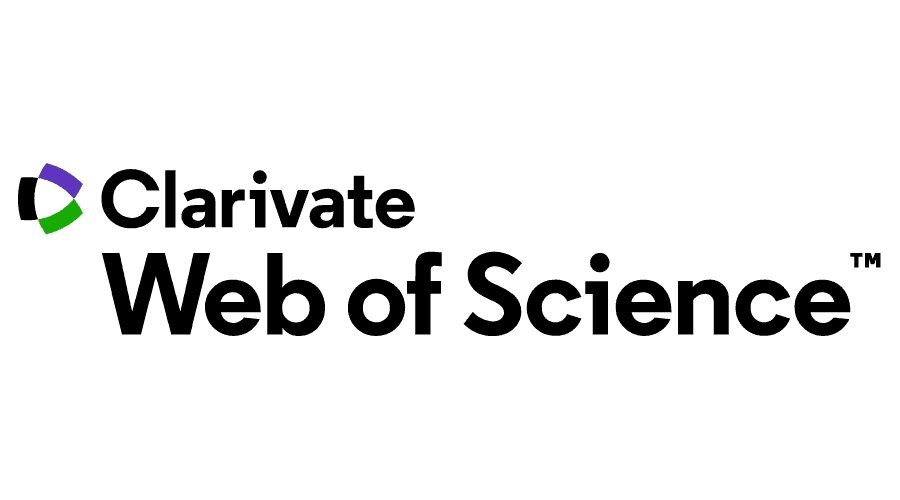 VILNIUS TECH community members can use Web of Science (hereinafter – WoS) database and its additional tools.
VILNIUS TECH community members can use Web of Science (hereinafter – WoS) database and its additional tools.Although the number and variety of bibliographic databases is growing rapidly, WoS remains the most influential bibliographic database, globally used for many years for both research evaluation and for daily tasks.
The majority of the academic community members (researchers, lecturers, and students) use bibliographic databases mainly for two purposes:
- Searching for the most relevant literature for studies, research, and preparation of graduation works or lectures;
- Choosing a journal for publication.
When using a database for literature search purposes, it is worth remembering that WoS is a bibliographic database, which means that it stores the metadata of publications, not the publications themselves. For open access publications links to their full texts are provided.
Yet, nowadays WoS is most commonly used because of the journal citation indicators it provides for evaluating indexed journals. These metrics are important when choosing a journal for publication or deciding on subscriptions. However, they are also applied in assessing the quality of publications. In principle, this is not a good practice, as citation indicators describe the average citation rate of a whole source (usually a journal), and are therefore intended to assess the quality of the journal, not an individual publications published in it.
Important! WoS DB and the analysis tools it provides are available from the university’s internal network. A VPN service is required to access the database and tools from an external network.
General Information
This database was established in 1964 under the name „Science Citation Index (SCI)™“ as a product of the Institute of Scientific Information (ISI). From 1992 the database was acquired by Thomson Reuters and was soon renamed Web of Science (WoS DB). From 2016 WoS is owned by ClarivateTM.
WoS DB is a platform consisting of a number of separate specialized databases (indexes), but the most important of these are concentrated in the WoS Core Collection part of the platform. Currently more than 21 000 journals, of which more than 12 000 journals have citation indicators, are indexed in WoS Core Collection.

The goal of WoS founder Eugene Garfield was to collect data of only the highest quality international scientific output. Therefore, WoS is a selective DB, meaning that only journals meeting strict selection criteria are indexed and periodically re-evaluated. Nevertheless, the content of the WoS DB covers all major disciplines, but in different proportions: the coverage of life, biomedicine, physical and technological sciences is the most comprehensive, while the coverage of Social Sciences, and especially Humanities, is much narrower and considered insufficient for reliable evaluations and data analyzes.

The goal of WoS founder Eugene Garfield was to collect data of only the highest quality international scientific output. Therefore, WoS is a selective DB, meaning that only journals meeting strict selection criteria are indexed and periodically re-evaluated. Nevertheless, the content of the WoS DB covers all major disciplines, but in different proportions: the coverage of life, biomedicine, physical and technological sciences is the most comprehensive, while the coverage of Social Sciences, and especially Humanities, is much narrower and considered insufficient for reliable evaluations and data analyzes.
Long years of use and domination have granted WoS with the title of "gold standard" which also lead to the inevitably increased price for its subscription. As a result, academic institutions typically cannot afford to subscribe the entire WoS DB platform. Therefore, institutions usually subscribe only to a WoS Core Collection part (often with additional content access restrictions).
The content of WoS Core Collection indexes (elsewhere also referred as Editions) available to VILNIUS TECH community members and the additional access restrictions on their depth, according to the subscription agreement renewed on April 2021, are presented in table 1.
Table 1. The content of the WoS Core Collection and its depth limits available to the university’s community.
Content access restrictions become especially important when evaluating the author's h-index values in WoS DB, since they are calculated only from the user-accessible DB content (both regarding publications and citation data).
The content of WoS Core Collection indexes (elsewhere also referred as Editions) available to VILNIUS TECH community members and the additional access restrictions on their depth, according to the subscription agreement renewed on April 2021, are presented in table 1.
Table 1. The content of the WoS Core Collection and its depth limits available to the university’s community.
| WoS Core Collection Index | Abbreviation | Full coverage depth | Part of the archive available under the license of Lithuanian universities (by depth) |
| MAIN INDEXES | |||
| Science Citation Index Expanded | SCIE | Since 1900 | Since 1990 |
| Social Sciences Citation Index | SSCI | Since 1900 | Since 1990 |
| Arts & Humanities Citation Index | A&HCI | Since 1975 | Since 1990 |
| Emerging Sources Citation Index | ESCI | Since 2005 | of 5 preceding years |
| CONFERENCE MATERIAL | |||
| Conference Proceedings Citation Index – Science | CPCI-S | Since 1990 | Since 1990 |
| Conference Proceedings Citation Index – Social Science & Humanities | CPCI-SSH | Since 1990 | Since 1990 |
| BOOKS | |||
| Book Citation Index – Science | BKCI-S | Since 2005 | Since 2005 |
| Book Citation Index – Social Sciences & Humanities | BKCI-SSH | Since 2005 | Since 2005 |
| REGIONAL DB | |||
| KCI-Korean Journal Database | KCI | Since 1980 | Since 1980 |
| SciELO Citation Index | SciELO | Since 1997 | Since 2002 |
Content access restrictions become especially important when evaluating the author's h-index values in WoS DB, since they are calculated only from the user-accessible DB content (both regarding publications and citation data).
WoS DB users can create their personal accounts:

Users who create free WoS accounts can additionally:
These functions are accessible and may be configured via the expanding signed-in user menu at the left-hand-side of the window:
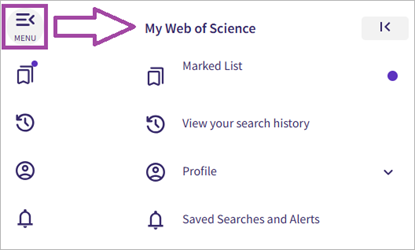
The lists of the last performed searches (Recent searches), most recently set alerts (Latest alerts), and according to the user’s search history recommended publications (Recommended for you) are also provided on the home page of the signed-in user.
Users are advised to create one WoS account and use it for all WoS products:

Users who create free WoS accounts can additionally:
- save performed searches and their settings;
- subscribe to new results based on performed searches (alert);
- select and create individual lists of publications (marked list) that can be saved (up to 50 lists can be saved);
- save and/or download the search results, and performed analysis reports in the desired format, as well as graphical representations (images) of the data;
- manage data stored in folders;
- WoS accounts are also required for usage of WoS analysis tools and/or their additional features;
- By creating a free Researcher ID account, authors can verify (Claim) their account membership, adjust their profile data, and link it to ORCID accounts.
These functions are accessible and may be configured via the expanding signed-in user menu at the left-hand-side of the window:

The lists of the last performed searches (Recent searches), most recently set alerts (Latest alerts), and according to the user’s search history recommended publications (Recommended for you) are also provided on the home page of the signed-in user.
Users are advised to create one WoS account and use it for all WoS products:
- User registration is required to use the InCites tool and download the lists of WoS indexed journals from the Master Journal List website.
- A personal account and registration are not required to use JCR and ESI tools. Registration is recommended if you want to create and manage reports saved in ESI folder, subscribe to a newsletter (alert), save the results or search settings, and perform other additional functions provided in these tools.
Search
Abilities to search for publications (Documents), Cited References, and Authors (Researchers) are available in the updated WoS interface.
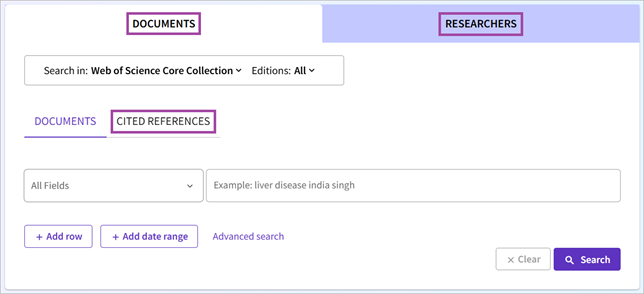

Document (and cited reference) search can be performed only within the WoS Core Collection part, in the content of all available DB sections, or in individual regional DBs (in these cases, the search and filtering options may be narrower than searching within WoS Core Collection content).
In 2023–2024, WoS DB was expanded by adding additional resources of specific documents (Preprint Citation Index and ProQuest™ Dissertations & Theses Citation Index) and grants (Grants Index) which content is included in the search while All Databases context is selected, but they also can be searched separately:
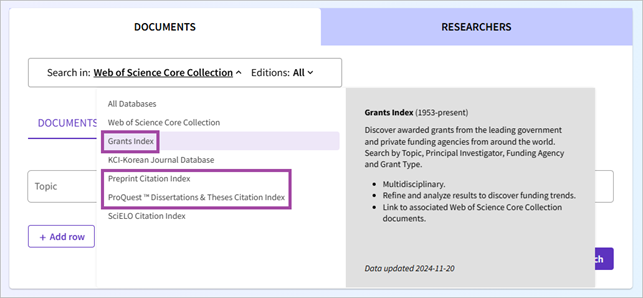
Upon selection to search within only WoS Core Collection part, the search context can be further specified by selecting only particular indexes (Editions):
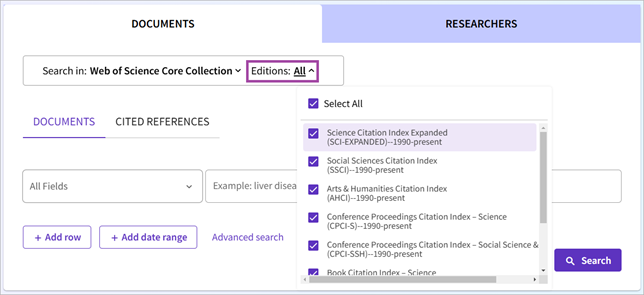
Publications can be searched: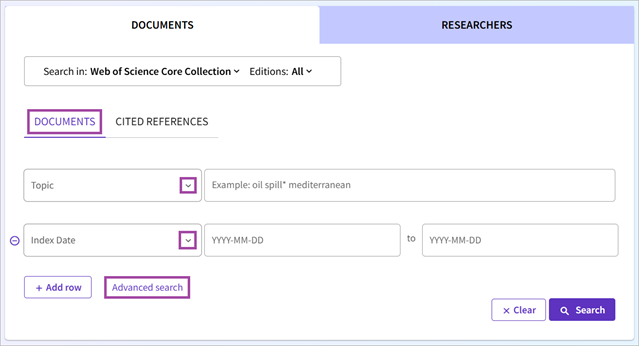
Obtained results (lists of publications) can be:
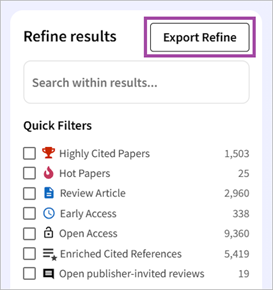
In 2023–2024, WoS DB was expanded by adding additional resources of specific documents (Preprint Citation Index and ProQuest™ Dissertations & Theses Citation Index) and grants (Grants Index) which content is included in the search while All Databases context is selected, but they also can be searched separately:

Upon selection to search within only WoS Core Collection part, the search context can be further specified by selecting only particular indexes (Editions):

Publications can be searched:
- within various data of document’s entry (by title, keywords, author, institution, title of the publication or publisher, etc.)
- by adding additional search fields (+Add row), which enables to search within several different fields at the same time
- the search can be additionally limited to a certain time period (by publication or by indexing (inclusion in WoS DB) date)
- Advanced Search is also available
- a search query can be formulated using abbreviations and search operators

Obtained results (lists of publications) can be:
- further narrowed/specified by applying various filters (Refine results)
- added to list (Add To Marked List)
- exported in various formats (Export)
- further analyzed (Analyze Results)
- their citation data reports can also be generated (Citation Report)

Cited references can be searched by:
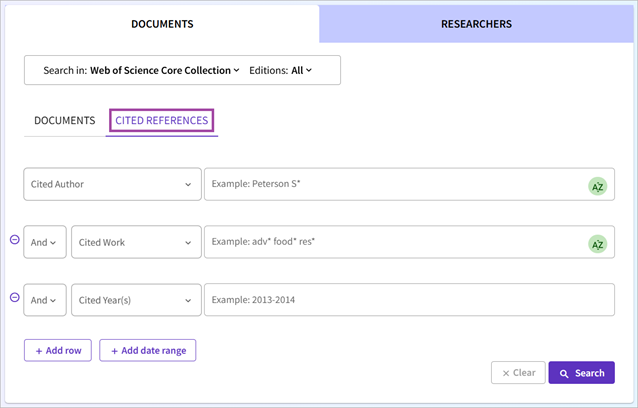
- the author of the cited publication,
- the data of the source in which the cited publication was published,
- the period of its publication (to the nearest year)

- a search query can be formulated using abbreviations and search operators
- a search can be refined by adding additional search fields
A part of cited references listed in WoS indexed publications are available with additional information indicating the purpose, context and the part of the publication where the reference have been mentioned.
This additional information is provided for the publications classified by a new citation context scheme, aiming to help assess the intents of the authors using these literature sources.
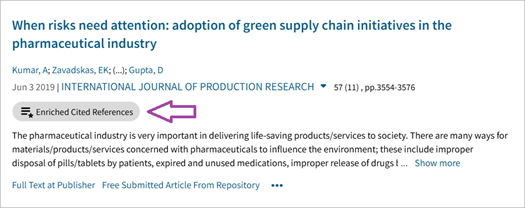
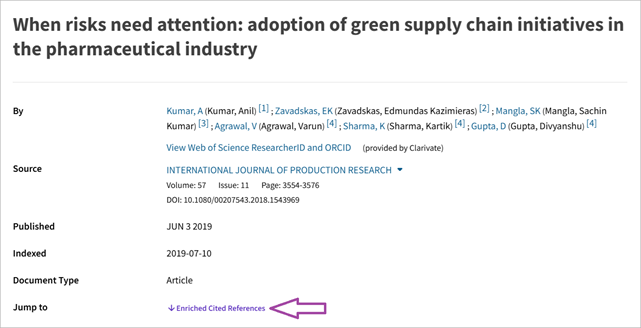
It should be mentioned, that the results obtained by document search can be also narrowed by this criterion:
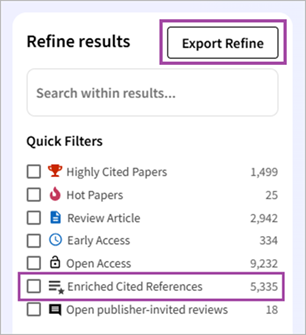
Even more detailed information on the cited references listed in the Enriched Cited References tagged publication is provided in the dot-plot diagram, included on the tagged publication’s page below the main information, just above the list of cited references.
In this diagram, every dot represents the cited reference, oriented according to the citing intent (vertical axis) and structural place in the text (horizontal axis):
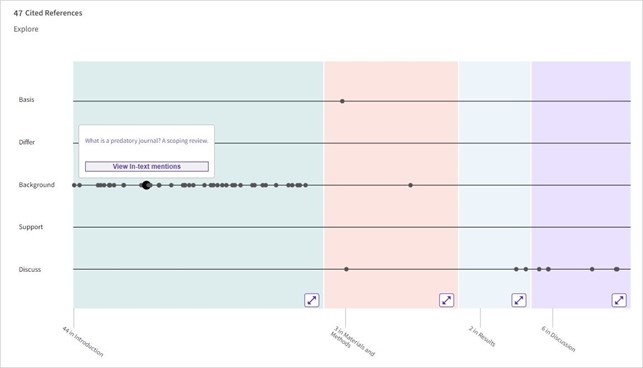
Hovering the mouse over a dot displays the title of the cited source and the link provided below it (View in-text mentions) leads to the cited source in the list along with an indication of a structural part of the publication where the source was cited and the specific passage of the text mentioning the source:
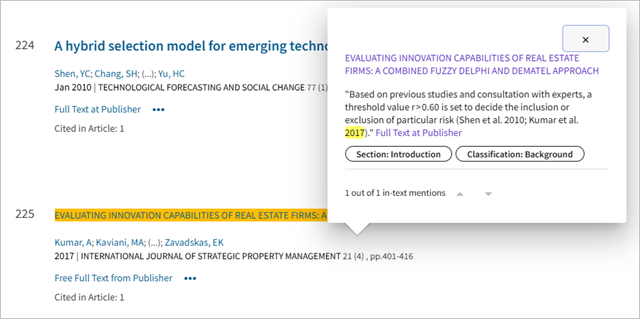
WoS DB allows to assess not only the purpose and the place of the literature sources mentioned in the publication, but also to evaluate the impact of the particular publication made on other studies. If a publication was at least once cited by other WoS indexed publications classified by the new citation context scheme, on the right hand side on the publications page the Citing items by classification graph is displayed:
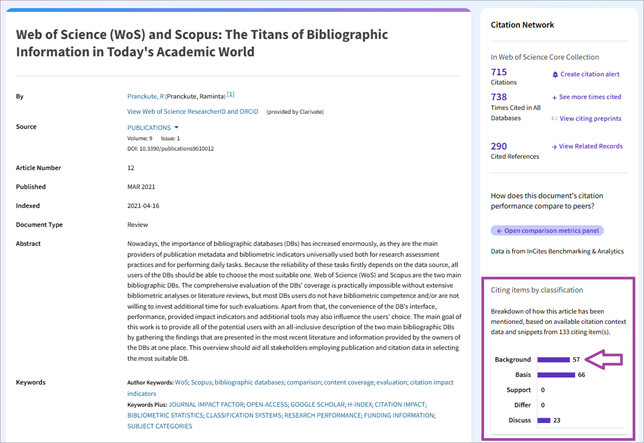
This graph is interactive and clicking on any of its elements redirects to the list of the corresponding citing publications, where below the entry of every publication not only a structural part of the citing source where the analyzed publication was cited, but also a specific passage of the text mentioning the publication (In-text mentions), are indicated:
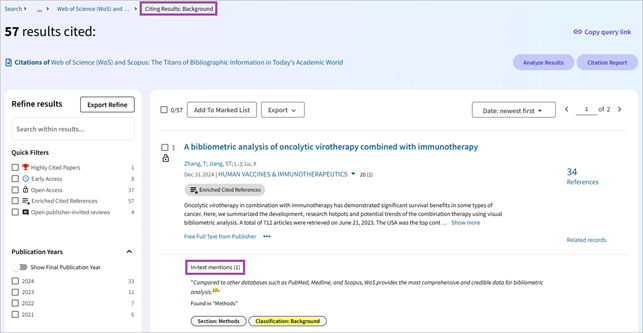
This additional information is provided for the publications classified by a new citation context scheme, aiming to help assess the intents of the authors using these literature sources.
- Background – previously published research that orients the study published in the analyzed publication within a scholarly area.
- Basis – references that report the data sets, methods, concepts and ideas that the author was using for his/her work directly or on which the work was based.
- Support – references which have similar results to the ones published in the analyzed publication. This may also refer to similarities in methodology or in some cases replication of results.
- Differ – references which reports differing results compared to the ones published in the analyzed publication. This may also refer to differences in methodology or differences in sample sizes, affecting results.
- Discuss – references allowing the study published in the analyzed publication to be discussed in more details and/or broader context.


It should be mentioned, that the results obtained by document search can be also narrowed by this criterion:

Even more detailed information on the cited references listed in the Enriched Cited References tagged publication is provided in the dot-plot diagram, included on the tagged publication’s page below the main information, just above the list of cited references.
In this diagram, every dot represents the cited reference, oriented according to the citing intent (vertical axis) and structural place in the text (horizontal axis):

Hovering the mouse over a dot displays the title of the cited source and the link provided below it (View in-text mentions) leads to the cited source in the list along with an indication of a structural part of the publication where the source was cited and the specific passage of the text mentioning the source:

WoS DB allows to assess not only the purpose and the place of the literature sources mentioned in the publication, but also to evaluate the impact of the particular publication made on other studies. If a publication was at least once cited by other WoS indexed publications classified by the new citation context scheme, on the right hand side on the publications page the Citing items by classification graph is displayed:

This graph is interactive and clicking on any of its elements redirects to the list of the corresponding citing publications, where below the entry of every publication not only a structural part of the citing source where the analyzed publication was cited, but also a specific passage of the text mentioning the publication (In-text mentions), are indicated:

From 2024 WoS Core Collection publication records (not older than 1980) include a link to the Comparison metrics panel, which provides data from the InCites Benchmarking & Analytics tool.
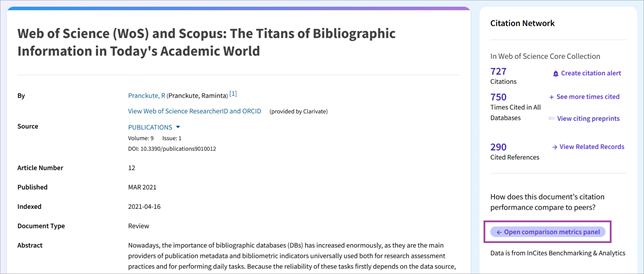
This feature helps to evaluate a selected publication based on its citation count in a broader context. The Comparison metrics panel provides 5 types of publication data:

This feature helps to evaluate a selected publication based on its citation count in a broader context. The Comparison metrics panel provides 5 types of publication data:
- Percentage of documents of the same type, from the same category and published in the same year that have a lower citation count than the selected paper (Percentile in subject area).
- Ratio of a document's actual times cited count to the expected count for a document of the same type, from the same category, and published in the same year (Category Normalized Citation Impact).
- Expected number of citations calculated from other items of the same type published in the same subject categories and year (Category expected citations).
- Ratio of a document's actual times cited count to the expected count for a document of the same type, from the same journal, and published in the same year (Journal Normalized Citation Impact).
- Expected number of citations calculated from other items of the same type published in the same journal and year (Journal expected citations).
You can search for authors:
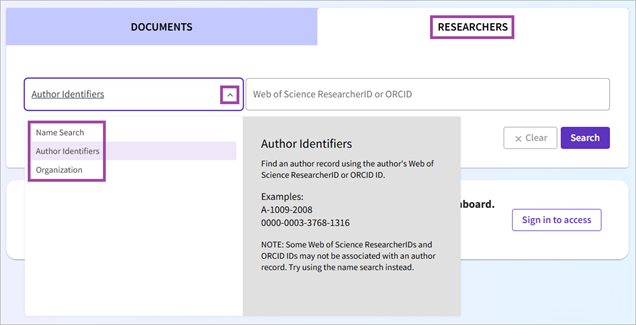
The search results include the author or a list of them (if there are multiple authors with the same last name):
- by author's last name and first name/initials (Name search); it is possible to add additional field(s) and search by the main and possible alternative variants of the author's surname / name at the same time
- by the institution represented by the author (Organization)
- authors can also be searched by their Researcher ID or ORCID identifiers (Author identifiers).

The search results include the author or a list of them (if there are multiple authors with the same last name):
- Additional information about the author's affiliation, number of publications, the period of publication, and the journals in which the author has published most often, is also provided in the search results.
- Search results can be refined by filtering by author names, author profile status, WoS categories, affiliations, countries/regions, Highly Cited Researcher award year, award category and other quick filters.
- If individual results include data from the same author, you can tag and view data from multiple authors grouped into one profile.
Analysis Tools
VILNIUS TECH community members can use the following tools accessible from WoS DB:
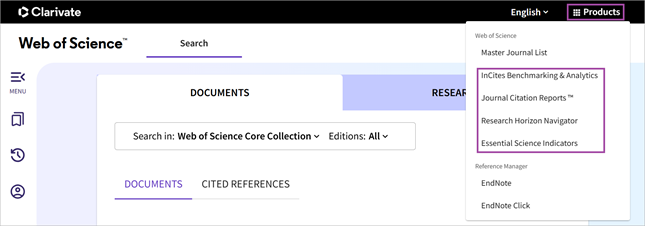
Important! All WoS analysis tools use data only of WoS Core Collection indexed publications and citations (data from specialized and regional DBs are not included). Accordingly, it is important to consider the additional possible restrictions on accessible WoS Core Collection content depth, as they often apply not only to the availability of publications, but also to the availability of citation data.
- Journal Citation Reports (JCR) – is a tool for evaluation of journals quality. It can be used to search for WoS CC indexed journals, review their citation indicator values and other information.
- Essential Science Indicators (ESI) – is a tool for assessing the most relevant and impactful research fields and trends.
- InCites Benchmarking &Analytics (InCites) is a tool to facilitate the analysis of WoS indexed research output by evaluating publication and citation counts and their distribution by various aspects and in different contexts. NEW! Research Horizon Navigator – a module of InCites, which helps to discover emerging research topics.

Important! All WoS analysis tools use data only of WoS Core Collection indexed publications and citations (data from specialized and regional DBs are not included). Accordingly, it is important to consider the additional possible restrictions on accessible WoS Core Collection content depth, as they often apply not only to the availability of publications, but also to the availability of citation data.
Journal Citation Reports (JCR) is an analytical tool intended for assessing the quality of journals. It allows to search the journals indexed in the WoS Core Collection databases and view their citation data and metrics, the relationship between article and journal citations, and other journal information. JCR provides transparent, publisher-neutral data and metrics that provide insight into the journal’s role and impact on the global research community.
Starting with the 2021 edition JCR has been generally renewed. Apart from the drastically changed user interface (both regarding structural layout and design), several conceptual and/or functional changes of the tool have also been implemented, with the most significant ones being:
More information on the JCR renewal and improvements implemented in 2021 can be found here >>>
The JCR provides a rich set of journal citation indicators, including the Journal Impact Factor (JIF), along with their trends.
The most important changes of indicators provided in JCR:
Detailed information on journals included in the JCR and their citation data for recent and previous years are provided in the JCR journal profiles. The latest values of journal citation indicators and journal ranks in WoS categories can also be viewed in the publication list data by clicking on the activated (blue) source title (if the title is not active, the source is not included in JCR, and it does not have JCR profile and citation indicators), and also from the individual publication entry, in the Journal Information section (at the bottom of the page).
More information about Web of Science database, additional analytical tools, main citation impact indicators and their usage is available on the VILNIUS TECH Library’s webpage Scientific Communication sections:
Starting with the 2021 edition JCR has been generally renewed. Apart from the drastically changed user interface (both regarding structural layout and design), several conceptual and/or functional changes of the tool have also been implemented, with the most significant ones being:
- Expanded coverage of journals: now JCR also includes publications indexed in the Arts & Humanities Citation Index (AHCI) and the Emerging Sources Citation Index (ESCI). The inclusion of these indexes in JCR (and also other WoS analysis tools) provides a broader and more representative coverage. This extension of JCR content is based on the fact that journals included in the AHCI and ESCI are subject to the same stringent quality requirements as the content of other main WoS indexes (e.g., Science Citation Index Expanded (SCIE) and Social Sciences Citation Index (SSCI)).
- JCR citation reports are generated using citation data from all main WoS Core Collection journal indexes, including citation data from the Arts & Humanities Citation Index (AHCI) and the Emerging Sources Citation Index (ESCI). From 2021 JCR also includes Early Access (EA) publications and citations data.
- JCR journal profiles now presents more detailed information regarding journal’s Open Access content by indicating all types of publishing models employed by the journal, and providing publication and citation data (and their graphical representations) of articles representing each of these publishing models.
More information on the JCR renewal and improvements implemented in 2021 can be found here >>>
The JCR provides a rich set of journal citation indicators, including the Journal Impact Factor (JIF), along with their trends.
The most important changes of indicators provided in JCR:
- Starting with the 2023 JCR edition, the main WoS journal citation indicator Journal Impact Factor (JIF) is calculated for all JCR (WoS Core Collection) journals, including ones indexed in the Arts & Humanities Citation Index (AHCI) and the Emerging Sources Citation Index (ESCI).
- From 2021, an additional Journal Citation Indicator (JCI) is calculated for all JCR (WoS Core Collection) journals, including ones indexed in AHCI and ESCI, and is displayed in all JCR journals’ profiles. JCI is a citation indicator normalized by discipline, developed aiming to provide opportunities for evaluation and direct comparison of quality of the journals representing all major disciplines (which is not possible to achieve by using JIF indicator). Detailed information about JCI calculation and interpretation is available here >>>.
- From 2023 edition, the JIF is displayed with only one decimal place instead of three (does not apply for the JIF values of the previous years).
Detailed information on journals included in the JCR and their citation data for recent and previous years are provided in the JCR journal profiles. The latest values of journal citation indicators and journal ranks in WoS categories can also be viewed in the publication list data by clicking on the activated (blue) source title (if the title is not active, the source is not included in JCR, and it does not have JCR profile and citation indicators), and also from the individual publication entry, in the Journal Information section (at the bottom of the page).
More information about Web of Science database, additional analytical tools, main citation impact indicators and their usage is available on the VILNIUS TECH Library’s webpage Scientific Communication sections:
Essential Science Indicators (ESI) it is an analytical tool intended to assess the most relevant and popular research fields and their global trends based on data from the WoS Core Collection. The ESI tool is most useful for comparing research outputs, identifying the most popular research fields and trends, ranking the best authors, institutions, countries, journals, and detecting the most impactful publications.
ESI data used for calculations
Publications: ESI analyzes data from scientific and review articles indexed by the Science Citation Index Expanded (SCIE) and Social Sciences Citation Index (SSCI) (letters, editorials, corrections, and similar types of publications are not highly cited and thus are not included in ESI data calculations).
Citation: Citation calculations include citations from articles, reviews, documents, and research notes published in journals indexed in Science Citation Index Expanded (SCIE), the Social Sciences Citation Index (SSCI), and the Arts & Humanities Citation Index (AHCI). Citations from books or book chapters, conference proceedings, letters, editorials, corrections, and similar documents types, and citations from articles published in sources indexed in other WoS indexes, including Emerging Sources Citation Index (ESCI), are not included in reports generated by the ESI.
Data period: Data for 10 years are analyzed on a sliding principle (data for the first year are discarded when full data for year 11th year is accumulated). Ratings and citations are updated every two months.
Research fields (categories): ESI tool employs an individual categorization of the research fields that is not related/dependent on the WoS Category Classification Scheme. ESI classification consists of 22 broad categories that do not overlap, i.e., each evaluated object in the ESI is assigned to only one science category.
Criteria for inclusion: Only authors, institutions, countries, journals and articles having the highest citation rates are included in the ESI. In order to be included in the ESI these entities must meet certain citation thresholds within a particular science category (Table 1).
Table 1. Citation thresholds that determine the inclusion of entities in ESI.
Definitions of the main concepts:
„Highly Cited Papers“ and „Hot papers“ allows to readily identify the most influential research in specific areas. Publications that meet the aforementioned criteria are also indicated with special icons in the WoS Core Collection search results or other publication lists:

Usage
The usage of ESI tool does not require to have WoS account. However, the tool, as well as all other WoS content and tools, can be accessed only from VILNIUS TECH network or by using VPN service.
For the most effective use of ESI it is required firstly to assess what will be analyzed (authors, institutions, journals, countries, publications), and what criteria will be applied for including the results in the report.
ESI data used for calculations
Publications: ESI analyzes data from scientific and review articles indexed by the Science Citation Index Expanded (SCIE) and Social Sciences Citation Index (SSCI) (letters, editorials, corrections, and similar types of publications are not highly cited and thus are not included in ESI data calculations).
Citation: Citation calculations include citations from articles, reviews, documents, and research notes published in journals indexed in Science Citation Index Expanded (SCIE), the Social Sciences Citation Index (SSCI), and the Arts & Humanities Citation Index (AHCI). Citations from books or book chapters, conference proceedings, letters, editorials, corrections, and similar documents types, and citations from articles published in sources indexed in other WoS indexes, including Emerging Sources Citation Index (ESCI), are not included in reports generated by the ESI.
Data period: Data for 10 years are analyzed on a sliding principle (data for the first year are discarded when full data for year 11th year is accumulated). Ratings and citations are updated every two months.
Research fields (categories): ESI tool employs an individual categorization of the research fields that is not related/dependent on the WoS Category Classification Scheme. ESI classification consists of 22 broad categories that do not overlap, i.e., each evaluated object in the ESI is assigned to only one science category.
Criteria for inclusion: Only authors, institutions, countries, journals and articles having the highest citation rates are included in the ESI. In order to be included in the ESI these entities must meet certain citation thresholds within a particular science category (Table 1).
Table 1. Citation thresholds that determine the inclusion of entities in ESI.
| Type of evaluated entity | Percentile | Data coverage (years) |
| Researchers | 1% | 10 |
| Institutions | 1% | 10 |
| Countries | 50% | 10 |
| Journals | 50% | 10 |
| Highly Cited Papers | 1% | 10 |
| Hot Papers (Most cited articles) | 0.1% | 2 |
Definitions of the main concepts:
- „Highly Cited Papers“ – articles with a high citation rate, which are among the 1% most cited articles compared to other articles published in the same year and in the same category.
- „Hot papers“ – articles published in the last 2 years. If the citation of these articles accounted for 0.1% of the total citation of articles in the same field and published at the same time in the WoS Core Collection within 2 months, then such articles fall within the ESI. The evaluation of articles for their inclusion in the ESI is performed every two months when citation data updates are performed.
- „Top papers“ – the sum of the publications attributable to „Highly Cited Papers“ and „Hot papers“. If a publication meets the criteria for both categories, it will only appear once in the „Top papers“ results.
- „Research Fronts“ – groups of the most cited articles in a specialized field/topic published in the last 5 years (called “Core Documents”). The assignment of publications to research fronts is not linked to the ESI's classification scheme. Therefore, Research Fronts can be used as an alternative way of classifying the most cited publications.
„Highly Cited Papers“ and „Hot papers“ allows to readily identify the most influential research in specific areas. Publications that meet the aforementioned criteria are also indicated with special icons in the WoS Core Collection search results or other publication lists:

Usage
The usage of ESI tool does not require to have WoS account. However, the tool, as well as all other WoS content and tools, can be accessed only from VILNIUS TECH network or by using VPN service.
For the most effective use of ESI it is required firstly to assess what will be analyzed (authors, institutions, journals, countries, publications), and what criteria will be applied for including the results in the report.
InCites Benchmarking & Analytics (InCites) – is a research evaluation tool for analyzing publication and citation data. It is primarily intended for administrators of academic institutions and government authorities to analyze the scientific productivity and output quality of institutions (or other evaluated entities) and to compare data in both national and international contexts.
Usage
InCites is the only WoS tool for which it is not enough to work from VILNIUS TECH computer network or with VPN - user registration is required (it is advisable to create a single WoS account and use it for all WoS products).
A video guide explaining the sign in into InCites procedure
InCites tool is designed to facilitate data analysis for evaluation purposes and to generate reports of evaluated entities (researchers, organizations, publishers).
With InCites tool various entities can be analyzed:
The tool also provides a range of analysis templates designed to answer specific questions, and a Resource Center (a question mark at the bottom of the right side) accompanying the user through all analysis steps and providing all the necessary information.
Data coverage
InCites uses data from publications and citations (since 1980; in Research Horizon Navigator module – from the last 5 years) indexed in all main WoS Core Collection indexes, which are updated monthly (usually at the end of the month).
Important! In default setup data from publications and citations indexed by Emerging Source Citation Index (ESCI) are not included in InCites analyzes, but may be included optionally.
Important! Some data in WoS database and InCites tool may not coincide due to the narrower extent of the data used in InCites.
In 2024, InCites tool was supplemented with the Research Horizon Navigator module, which can help to:
Detailed information and usage instructions:
Usage
InCites is the only WoS tool for which it is not enough to work from VILNIUS TECH computer network or with VPN - user registration is required (it is advisable to create a single WoS account and use it for all WoS products).
A video guide explaining the sign in into InCites procedure
InCites tool is designed to facilitate data analysis for evaluation purposes and to generate reports of evaluated entities (researchers, organizations, publishers).
With InCites tool various entities can be analyzed:
- Researchers – allows to evaluate the research results of individual researchers.
- Organizations – intended for the evaluation of organizations in various aspects. For example, for evaluation of the collaboration levels between institutions, or for comparison of organizations performance in different research areas.
- Departments – allows to evaluate and compare organization’s departments.
- Locations – allows to evaluate the trends of international cooperation, and to determine and compare the dominant research areas in different countries.
- Research Areas – allows to identify the most developed research areas and the impact of performed research within your own and other institutions.
- Publication Sources – allows to identify sources most commonly used for publishing by the institution's researchers.
- Funding Agencies – helps funders, analysts, researchers and publishers to assess the impact of their funded research.
The tool also provides a range of analysis templates designed to answer specific questions, and a Resource Center (a question mark at the bottom of the right side) accompanying the user through all analysis steps and providing all the necessary information.
Data coverage
InCites uses data from publications and citations (since 1980; in Research Horizon Navigator module – from the last 5 years) indexed in all main WoS Core Collection indexes, which are updated monthly (usually at the end of the month).
Important! In default setup data from publications and citations indexed by Emerging Source Citation Index (ESCI) are not included in InCites analyzes, but may be included optionally.
Important! Some data in WoS database and InCites tool may not coincide due to the narrower extent of the data used in InCites.
In 2024, InCites tool was supplemented with the Research Horizon Navigator module, which can help to:
- Discover emerging research topics.
- Track the contribution of organizations in various research areas.
- Identify authors of foundational papers.
- Better understand interdisciplinarity of various research topics, etc.
Detailed information and usage instructions:
More information on WoS content and usage is provided here >>>
-
- Page administrators:
- Jolanta Juršėnė
- Asta Katinaitė-Griežienė
- Olena Dubova
- Orinta Sajetienė
- Ugnė Daraškevičiūtė


